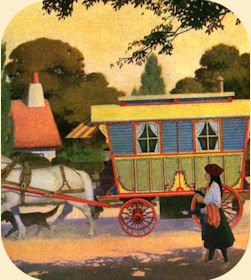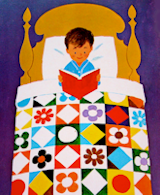Today, Maddie read Chapter 2 of The Wind in the Willows, which begins with Toad showing the Rat and the Mole his new gypsy caravan. After we discussed the chapter, she was asked to draw a picture of a gypsy wagon or vardo. As it happens, I had just been reading about "gypsy caravans" the night before in How the Heather Looks, so naturally this led us to some impromptu research: Gypsy Waggons being very informative, and the photos here simply gorgeous. If I should ever become very wealthy, I *must* have one of these!
UPDATE: In resuming my reading of How the Heather Looks, I was pleased to find another caravan reference here:
"I have wanted to live in a caravan ever since I was ten years old and read a book called The Slow Coach, by E.V. Lucas. It is about a family of English children who receive a caravan delivered to their door mistake, and who set along the dusty roads on a series of delightfully pastoral adventures. The book has the same Robinson Crusoe quality that the Arthur Ransome books have, although itwas written a generation earlier and is long out of print. I had not been able to find a copy to read to Ian, but I think I managed to communicate some of its charm by telling him about it and finding substitutes. We read Doctor Dolittle's Caravan by Hugh Lofting and The Fairy Caravan by Beatrix Potter..."
A quick Google search revealed that The Slow Coach is available from Google Books, which makes me seriously happy because that means I can have a copy printed!

- The first written record referring to gypsies in England was in 1505 (a timeline can be found here), though they were mistakenly believed to be Egyptians, which is how they came to be called "Gypsies."
- Gypsy caravans were not used in Britain until around 1850.
- John Bunyan may have been of Roma descent.
- The Gypsy Lore Society (founded in 1888) has much of interest, several of their journals are available via Google Books.
- At Google Books: A History of the Gipsies by Walter Simson (c. 1865), Lavengro and The Romany Rye by George Henry Borrow (Classic 19th-century accounts of life among the Romani in England), In Gipsy Tents and Gipsy Folk-Tales by Francis H. Groome
- A brief article on the portrayal of Gypsies in British Literature
- Gypsies and the British Imagination, 1807-1930
I've long had a deep, abiding fascination with Romani culture (much to my husband's distress), and music in particular ~ oh, the music! Several years ago, I discovered the films of Tony Gatlif, a director of Roma descent whose films are especially rich with Romani music and dance. Really, one must watch them for the music! In particular, I loved Gadjo Dilo; I was thrilled to see that he currently has a new film out, Liberté. Here are a couple of clips from his films Gadjo Dilo and Vengo:
"Tutti Frutti" from Gadjo Dilo
"Arrinconamela" from Vengo
"Arrinconamela" from Vengo
Labels: Literature
0 Comments:
Subscribe to:
Post Comments (Atom)























